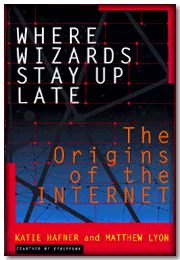Where Wizards Stay Up Late
The Origins of the Internet
by
Katie Hafner and Matthew Lyon
Simon and Schuster 1996 ISBN 0-684 81201-0
$24.00 320 pages
Reviewed by John F. Barber
 In the late 1960s the Defense Department's Advanced Research Projects Agency
(ARPA) funded a research project designed to develop a way to connect different
computers and foster point-to-point communications among its university-based
researchers around the country. In 1969, the contract to build the most
integral component of this envisioned computer network was awarded to a small
Cambridge, MA consulting firm called Bolt Beranek and Newman (BBN). Working
around the clock, BBN developed a computerized switch, called an Interface
Message Processor (IMP), designed to connect host
computers at the four original research sites with the transcontinental
telephone lines that formed the backbone of ARPA's network.
In the late 1960s the Defense Department's Advanced Research Projects Agency
(ARPA) funded a research project designed to develop a way to connect different
computers and foster point-to-point communications among its university-based
researchers around the country. In 1969, the contract to build the most
integral component of this envisioned computer network was awarded to a small
Cambridge, MA consulting firm called Bolt Beranek and Newman (BBN). Working
around the clock, BBN developed a computerized switch, called an Interface
Message Processor (IMP), designed to connect host
computers at the four original research sites with the transcontinental
telephone lines that formed the backbone of ARPA's network.
The ARPAnet was an immediate success and allowed
resource sharing related to military research as intended. But, it was the
desire for personal communication that powered the growth of the network
through the next decade. Soon after its inauguration, the majority of ARPAnet
traffic was personal email or ongoing listserv discussions. By the end of the
1980s, technological refinements and an incredible increase in non-military
related traffic generated by a growing number of other computer networks
connecting to ARPAnet prompted turning part of ARPAnet into a military network.
The rest was merged with other networks to form what we now call the Internet,
a world-wide collection of interconnected computer networks still used
primarily for personal communications.
Katie Hafner and Matthew Lyon's Where Wizards Stay Up Late: The Origins
of the Internet is an account of this story. It is also provides
little known behind the scenes facts and interesting anecdotes. For example,
Hafner and Lyon tell how huge corporations like IBM, AT&T, and the U. S. Postal
Service failed to see the potential of ARPAnet and its basic concept of packet
switching and turned down opportunities to own the network as a monopoly
service. Hafner and Lyon chronicle the origins of digital culture features
like flaming, emoticons, the @sign, and discussion groups.
Where Wizards Stay Up Late tells the story of computer pioneers who invented the basis of a
digital world which many of us consider every bit as fundamental as the earth,
air, fire, and water basis of our real world.
External Links to Additional Resources
Simon and Schuster
[http://www.simonsays.com] maintains an extensive series of WWW pages to promote its catalog of books. A
search engine that allows author or title searches is available at the top
page. Information provided about Simon and Schuster publications may include
press releases, reviews, and other resource materials in associated WWW sites.
For example, Where Wizards Stay
up Late, [http://www.simonsays.com/titles/0684812010/index.html], the companion website for this book, provides links to information
about the people who built the very first ARPA network, information about the
hardware they designed and built, early maps of the ARPA network, and links to other
resources associated with the origins of the Internet.
IMP pictures and
information are available at this address:
[http://www.simonsays.com/titles/0684812010/shop.html].
Early ARPAnet maps are
available at this address:
[http://www.simonsays.com/titles/0684812010/map.html].
Computer
pioneers biographies and pictures are available at this address:
[http://www.simonsays.com/titles/0684812010/pioneers.html].
 RETURN TO
INTRODUCTION
RETURN TO
INTRODUCTION
COMMENTS
Dr. John F. Barber
Department of Language and Communication
Northwestern State University
Natchitoches, LA 71497
jfbarber@alpha.nsula.edu
 In the late 1960s the Defense Department's Advanced Research Projects Agency
(ARPA) funded a research project designed to develop a way to connect different
computers and foster point-to-point communications among its university-based
researchers around the country. In 1969, the contract to build the most
integral component of this envisioned computer network was awarded to a small
Cambridge, MA consulting firm called Bolt Beranek and Newman (BBN). Working
around the clock, BBN developed a computerized switch, called an Interface
Message Processor (IMP), designed to connect host
computers at the four original research sites with the transcontinental
telephone lines that formed the backbone of ARPA's network.
In the late 1960s the Defense Department's Advanced Research Projects Agency
(ARPA) funded a research project designed to develop a way to connect different
computers and foster point-to-point communications among its university-based
researchers around the country. In 1969, the contract to build the most
integral component of this envisioned computer network was awarded to a small
Cambridge, MA consulting firm called Bolt Beranek and Newman (BBN). Working
around the clock, BBN developed a computerized switch, called an Interface
Message Processor (IMP), designed to connect host
computers at the four original research sites with the transcontinental
telephone lines that formed the backbone of ARPA's network.